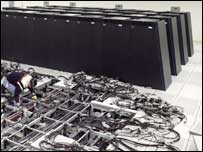
It takes a supercomputer to mimic a mouse brain
|
US researchers have simulated half a virtual mouse brain on a supercomputer.
The scientists ran a "cortical simulator" that was as big and as complex as half of a mouse brain on the BlueGene L supercomputer.
In other smaller simulations the researchers say they have seen characteristics of thought patterns observed in real mouse brains.
Now the team is tuning the simulation to make it run faster and to make it more like a real mouse brain.
Life signs
Brain tissue presents a huge problem for simulation because of its complexity and the sheer number of potential interactions between the elements involved.
The three researchers, James Frye, Rajagopal Ananthanarayanan, and Dharmendra S Modha, laid out how they went about it in a very short research note entitled "Towards Real-Time, Mouse-Scale Cortical Simulations".
Half a real mouse brain is thought to have about eight million neurons each one of which can have up to 8,000 synapses, or connections, with other nerve fibres.
Modelling such a system, the trio wrote, puts "tremendous constraints on computation, communication and memory capacity of any computing platform".
The team, from the IBM Almaden Research Lab and the University of Nevada, ran the simulation on a BlueGene L supercomputer that had 4,096 processors, each one of which used 256MB of memory.
Using this machine the researchers created half a virtual mouse brain that had 8,000,000 neurons that had up to 6,300 synapses.
The vast complexity of the simulation meant that it was only run for 10 seconds at a speed ten times slower than real life - the equivalent of one second in a real mouse brain.
On other smaller simulations the researchers said they had seen "biologically consistent dynamical properties" emerge as nerve impulses flowed through the virtual cortex.
In these other tests the team saw the groups of neurons form spontaneously into groups. They also saw nerves in the simulated synapses firing in a ways similar to the staggered, co-ordinated patterns seen in nature.
The researchers say that although the simulation shared some similarities with a mouse's mental make-up in terms of nerves and connections it lacked the structures seen in real mice brains.
Imposing such structures and getting the simulation to do useful work might be a much more difficult task than simply setting up the plumbing.


~RS~q~RS~~RS~z~RS~54~RS~)